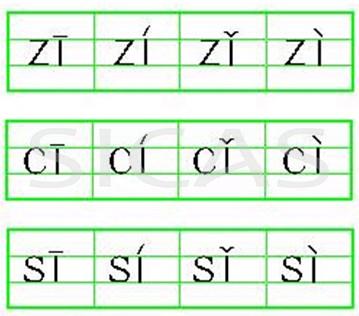
|
The Tones of Mandarin Chinese

The 1st, 2nd,3rd, 4th tones of Mandarin Chinese
Mandarin Chinese has five tones – 1st, 2nd,3rd, 4th, and neutral
A high note first tone
Arguably the easiest tone for westerners to master as it doesn’t fluctuate. The 1st tone starts high and ends high. There is no variation during its annunciation. Simple words that include a first tone are
māma 妈妈 (mother), shū书 (book), and bēizi 杯子(cup).
A rising second tone
Go ahead and say the word “huh?” to yourself? Did you hear it? Say “huh?” again, like the way you do when confused. Yep, that’s the second tone in Mandarin Chinese. It starts low and ends at the high pitch of a first tone. Simple second tone words include shénme什么(what),xuéxí学习(learn), wán玩(play).
A dipping third tone
By “dipping” I mean it starts at low-mid level dips a degree lower then rises two degrees. The third is an interesting one because it is rarely fully pronounced. If the 3rd tone is preceded by a 1st, 2nd, 4th or neutral tone it is enunciated just after the dip. Simple words including a third tone are wǒ我(me,I), mǎi 买(buy), and wǎn碗(bowl). If there are two 3rd tone words next to each other the first 3rd tones turns into a 2nd tone. Examples of this are wǒ mǎi le我买了(I bought [it]). If there are more than two 3rd tones in a row all but the last tone gets changed into a 2nd tone. Confused? Its OK it will come with time.
A descending fourth tone
Before I learned Chinese it seems as though Chinese people were always arguing with each other. I think this is due to the 4th tone. Say the word “Hey!” in a commanding way. One more time. Ok, when you say “hey” it’s a perfect example of the 4th tone. It starts at the top and finishes at the bottom. Simple examples of the 4th tone are mài卖(sell), qù去(go), and dìdi弟弟(younger brother). There is also a tone change rule and it’s when the 4th tone it preceded by a 1st tone. It’s when this situation occurs the 1st tone actually changes into a 2nd tone. Examples of this are wǒ jiào我叫(I’m called…[name]) and bú mài不卖([I] won’t sell [it])
Neutral tone
Just as the name states, its neutral. The best way to explain where this tone lays is somewhere in the middle and is never enunciated with emphasis (not that it is possible). Two classic examples are māma妈妈 (mother) and bàba爸爸(dad). The first character is said with a 1st tone then the second character is a neutral tone. For father the first character is a 4th tone and the second character is a neutral tone. As always emphasize the first character and under emphasize the second character with the neutral tone.
|










